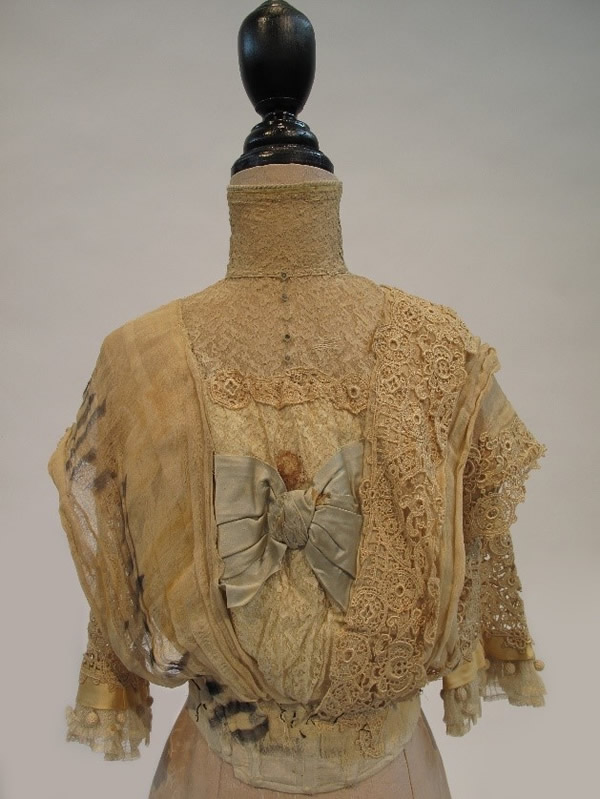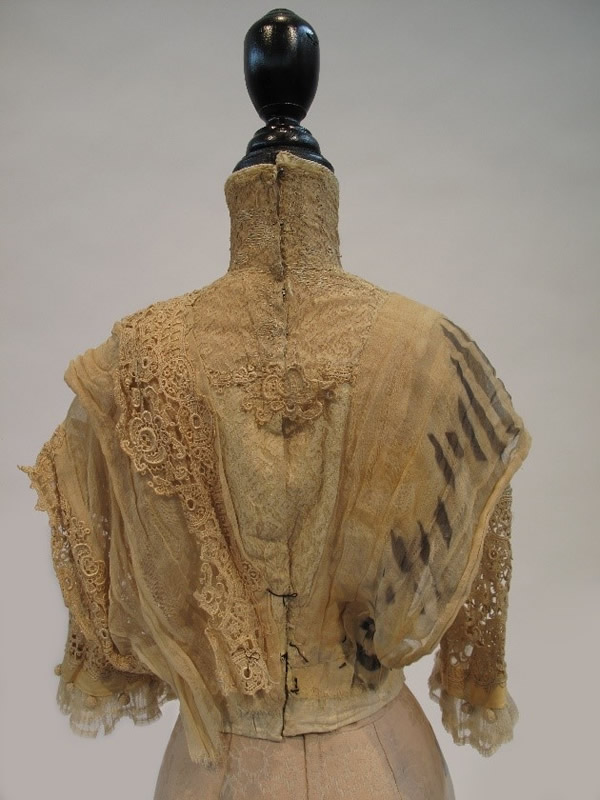Overview
This bodice is made of lightweight cream cotton gauze and has asymmetrical flanges over the shoulders. It is characteristic of the Edwardian period with its soft draped fabrics and pouter pigeon front. Its light color is characteristic of the period as Alison Gernsheim in Victorian and Edwardian Fashion: A Photographic Survey states on page 84 that in this time period "more white was worn than at any time since the days of Napoleon I."
She also describes the popular use of lightweight fabrics such as gauze. Photography and fashion plates from the era indicate that the earlier years of the period are characterized by fuller sleeves, fullness in the cap lingering from the previous decade, and then later bishop sleeves full at the wrist (Edwardian Fashion, Pauline Stevenson). The sleeves on this bodice are relatively shapeless lengths of lace with ruffles indicating the mid to latter half of the decade. Although Gernsheim states the pouch was most fashionable in 1905, it persisted afterwards. Jean Hunnisett discusses on page 166 in Period Costumes for Stage and Screen: Patterns for Womens Fashion, 1800-1909 that wider sloping shoulders became more pronounced beginning in 1904.
This was emphasized with wide lace collars or flounces. The side flanges of this bodice are seen most in style in the years 1906-1908. By 1907, Gernsheim states on page 90 that the waistline begins to raise slightly and loosen, and the frills of the previous years are less fashionable. Janet Arnold in Patterns of Fashion 2 analyzes a 1908 bodice with similar pleated flanges, but the blouson is significantly less than the examples from a few years earlier. After reviewing these characteristics, this bodice is most likely from c. 1905-1907.
Figure 1: Bodice Front |
Figure 2: Bodice Back |
 |
 |
Description
The bodice consists of a gauze layer mounted onto a fitted base with a lace yoke and high collar. The gauze does not extend all the way to the bottom of the base, and the raw edges seen in figure 3 indicate that the bodice was most likely stitched into a coordinating skirt. The center front and center back panels of the over-layer are made of a very fine, lightweight lace with a layer of pale yellow China silk beneath. The front panel is stuffed with lightweight fabric (difficult to see as the space is enclosed) to give the pouch look of the period. There is a pale green satin bow at center front (figure 4). The gauze side panels of the bodice extend from side front to side back with a seam at the shoulder but without a side seam. There is no shaping and the fullness is gathered down at the hem. This layer also has the same China silk from the front and back panels under the gauze. Most of the side panels are obscured by the asymmetrical flanges.
Figure 3: Raw Edges of Gauze Overlay |
Figure 4: Center Front Detail |
 |
 |
The right flange is a gauze panel 9" wide with a 1.25" hem on the outer edge. It is gathered down at the waist on the front and back and has painted floral and stripe details (figure 5). There are faded yellow roses and also green leaves which are barely visible. Along the flowers are short black stripes that perhaps matched an attached black skirt, as there are black threads visible at the waistline where the bodice was separated. The left flange is a 16" wide gauze panel pleated in three layers (figure 6). The top-most section is covered by guipure lace trim. The middle is just the gauze, tacked to the bodice beneath the upper-most layer, and the bottom layer has another row of the same guipure lace, but part of the motif is cut away to be a narrower strip. This side is also gathered down at the waist at the front and back. The flanges on both sides are stitched along the edge of the center front and back lace panels and along the yoke edge.
Figure 5: Painted Detail on Right Flange |
Figure 6: Left Flange |
 |
 |
Underbodice
The fitted base is made of a very fine linen batiste and is constructed with six panels in the back. There are two panels at the front with a center front seam and two darts on either side for shaping. There is a horizontal fisheye dart through the center front at bust level and darts in the front armscyes. The seams and darts are stitched to face out and be covered with the outer layers, omitting the need for seam finishing. There are 12 bones, each around 5" long, none of them going up past the low bustline of the period (figure 7). All but one set are stitched on seams or darts. This is the tail end of the era of boned bodices and this would have been worn over a long corset, creating the S-shape of the period. To fill in the hollow between the armscye and the breast, padded eggs are stitched into the bodice at the armscye. They are quite large, extending past the underarm point. This could be to add slight width to the bustline, as this was the desired silhouette of the period in which it was constructed. The bodice hits just below waist level in the back and dips down 2.5" below waist in the front. The hem of the base is finished with a bias facing on the inside.
Figure 7: Bodice Interior: Bones and Padded Eggs |
 |
Both the base and over-layers are combined into a squared-off neckline, and this space is filled in with a yoke on the front and back. The yoke is made of the same net lace of the center panels and is lined with an even finer weight of China silk. The bodice is top-applied to the yoke, hand stitched, with the seam allowances of the yoke left raw. The front yoke has five small square buttons with tiny jewels in the center. One of the buttons is missing its jewel. The bottom edges of the yokes are covered with small pieces of lace, motifs cut from the guipure lace used on the left flange (figure 8). The standing collar is stitched to the yoke and is made of the same lace and China silk layers. The collar is very tall and measures 3.5" high at center front and 4" at center back. It is supported by six wire wiggle bones (figure 9) that are sandwiched between the lace and China silk. The top edge is decorated with yellow satin piping and a decorative cord.
Figure 8: Front Yoke and Collar |
Figure 9: Detail: Collar Wiggle Bone |
 |
 |
The bodice closes at the center back, as seen in figure 10. There are six hooks and bars down the collar and yoke. The rest of the bodice has sections of alternating hooks and eyes and hooks and bars in the following pattern: four sets of hooks and eyes, two sets of hooks and bars, three sets of hooks and loops. The lace motif that covers the lower edge of the back yoke is stitched to the left side and closes with a hook and bar.
Figure 10: Closures Down Center Back |
 |
The sleeves have a top section of gauze, with the seam towards the front, that is eased into the armscye. The seam allowance of the armscye is hand overcast (figure 11). The gauze section is short, measuring 6" at the overarm and 3" at the underarm, and mostly hidden by the flanges on the bodice. Attached to the gauze is a 3/8" wide bias band of the pale green satin of the center front bow and the same guipure lace decorating the left flange. The trim is at its widest here and seems to have been cut down for both sections of the flange, as it appears to be one unpieced strip 6" long. This lace portion of sleeve is 11" around with the seam join carefully hidden in the motif. At the bottom edge of the lace is a 1" wide band of the yellow satin decorating the collar. The band covers the ribbon portion of the attached crochet ball fringe. Two layers of pleated bobbinet ruffles create the bottom of the sleeve. The ruffles are finished top and bottom with a machine chainstitched hem (figure 12).
Figure 11: Detail: Armscye Finishing |
Figure 12: Sleeve Details |
 |
 |
Damage
While in relatively good condition, the bodice has sustained some damage due to wear over the years. Some portions of the gauze over-layer, especially on the left flange, have come apart from the base as the layers are just hand basted together. Also on the left flange, some of the hand tacking keeping the pleated layers folded have come undone, probably giving way to the weight of the lace. There is a stain center front just above and on the bow, perhaps from some food or beverage spilled on the bodice. There is also some staining from wear at the underarms of the sleeves (figure 13). The inside of the bodice base has a hand-stitched dart asymmetrical from the rest. This could have been a quick alteration point or could be a repair covering where a hole had formed (figure 14). The net lace on the collar and yoke shows significant repairs with thick threads carefully stitched in a woven pattern (figure 15). The China silk on the inside of the yoke is pulling away from the seams in some areas and also has some tears (figure 16).
Figure 13: Underarm Stains |
Figure 14: Dart Used to Repair or Alter |
 |
 |
Figure 15: Repairs on Collar |
Figure 16: Tears on Lining of Collar and Yoke |
 |
 |
Provenance
There are no makers labels or owner name in the garment, and there is no information on the donor. The origin of this bodice and what skirt or belt it might have been paired with is unknown. The fine fabrics and lace used in its construction and the complex bodice closures that would require a maid’s assistance in dressing indicate that the owner was of some wealth.
© Michelle Bentley, 2017

